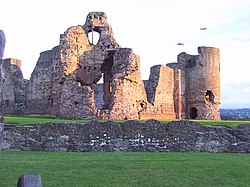Rhuddlan: Difference between revisions
Created page with '{{Infobox town |county=Flintshire |welsh= |picture=Rhuddlan Castle.jpg |picture caption=Rhuddlan Castle |os grid ref=SJ025785 |latitude=53.294 |longitude=-3.464 |name=Rhuddlan |p…' |
mNo edit summary |
||
| (One intermediate revision by the same user not shown) | |||
| Line 16: | Line 16: | ||
|constituency=Vale of Clwyd | |constituency=Vale of Clwyd | ||
}} | }} | ||
'''Rhuddlan''' is a town in western [[Flintshire]]. It is situated to the south of the coastal town of [[Rhyl]] and overlooks the River Clwyd. At the 2001 Census, the population was 4,296.<ref name=2001Census>{{citation|url=http://neighbourhood.statistics.gov.uk/dissemination/LeadTableView.do?a=3&b=801638&c=rhuddlan&d=16&e=15&g=414179&i=1001x1003x1004&m=0&r=1&s=1214828168544&enc=1&dsFamilyId=779|title=2001 Census: Rhuddlan|publisher=Office for National Statistics|accessdate=30 June 2008}}</ref> | '''Rhuddlan''' is a town in western [[Flintshire]]. It is situated to the south of the coastal town of [[Rhyl]] and overlooks the [[River Clwyd]]. At the 2001 Census, the population was 4,296.<ref name=2001Census>{{citation|url=http://neighbourhood.statistics.gov.uk/dissemination/LeadTableView.do?a=3&b=801638&c=rhuddlan&d=16&e=15&g=414179&i=1001x1003x1004&m=0&r=1&s=1214828168544&enc=1&dsFamilyId=779|title=2001 Census: Rhuddlan|publisher=Office for National Statistics|accessdate=30 June 2008}}</ref> | ||
==History== | ==History== | ||
Rhuddlan has a longer history than the castle fortress built following Edward I of England's Conquest of Wales. Prior to Norman occupation of lower Gwynedd, the Perfeddwlad, Rhuddlan was the site of a Welsh cantref and served as the seat of government for the Welsh king Gruffydd ap Llywelyn (1007 – August 5, 1063), whose family may have been the traditional Welsh lords of Rhuddlan for generations. | Rhuddlan has a longer history than the castle fortress built following Edward I of England's Conquest of Wales. Prior to Norman occupation of lower [[Gwynedd]], the Perfeddwlad, Rhuddlan was the site of a Welsh cantref and served as the seat of government for the Welsh king Gruffydd ap Llywelyn (1007 – August 5, 1063), whose family may have been the traditional Welsh lords of Rhuddlan for generations. | ||
The town is known for the ruins of Rhuddlan Castle, built by Edward I from 1277 to 1282, and for the site of another castle at Twthill, built by the Norman Robert of Rhuddlan about 1072. | The town is known for the ruins of Rhuddlan Castle, built by Edward I from 1277 to 1282, and for the site of another castle at Twthill, built by the Norman Robert of Rhuddlan about 1072. | ||
| Line 37: | Line 37: | ||
{{reflist}} | {{reflist}} | ||
== | ==Outside links== | ||
*[http://www.geograph.org.uk/search.php?i=3481561 www.geograph.co.uk: photos of Rhuddlan and surrounding area] | *[http://www.geograph.org.uk/search.php?i=3481561 www.geograph.co.uk: photos of Rhuddlan and surrounding area] | ||
[[Category:Towns and villages in Flintshire]] | [[Category:Towns and villages in Flintshire]] | ||
Latest revision as of 21:10, 13 December 2015
| Rhuddlan | |
| Flintshire | |
|---|---|
 Rhuddlan Castle | |
| Location | |
| Grid reference: | SJ025785 |
| Location: | 53°17’38"N, 3°27’50"W |
| Data | |
| Population: | 4,296 (2001) |
| Post town: | Rhuddlan |
| Postcode: | LL18 |
| Dialling code: | 01745 |
| Local Government | |
| Council: | Denbighshire |
| Parliamentary constituency: |
Vale of Clwyd |
Rhuddlan is a town in western Flintshire. It is situated to the south of the coastal town of Rhyl and overlooks the River Clwyd. At the 2001 Census, the population was 4,296.[1]
History
Rhuddlan has a longer history than the castle fortress built following Edward I of England's Conquest of Wales. Prior to Norman occupation of lower Gwynedd, the Perfeddwlad, Rhuddlan was the site of a Welsh cantref and served as the seat of government for the Welsh king Gruffydd ap Llywelyn (1007 – August 5, 1063), whose family may have been the traditional Welsh lords of Rhuddlan for generations.
The town is known for the ruins of Rhuddlan Castle, built by Edward I from 1277 to 1282, and for the site of another castle at Twthill, built by the Norman Robert of Rhuddlan about 1072.
The town was also the location where Edward I signed the Statute of Rhuddlan, laying down the way by which the Principality of Wales, created by the princes of Gwynedd, was to be governed.
Rhuddlan railway station was part of the Vale of Clwyd Railway until it closed in the 1960s.
A fossil of a pterosaur was believed to have been discovered in Rhuddlan in the early 1990s.
In 2001, the A525 bypass road was completed, easing access to Rhyl, and since then the centre of Rhuddlan has been redeveloped.
Notable people
Photographer Philip Jones Griffiths, well known for his photographs during the Vietnam War, was born in Rhuddlan. Wales and Sunderland footballer David Vaughan was also born in the town. Lisa Scott-Lee of the pop band Steps and her brother Andy Scott-Lee lived in Rhuddlan.
References
- ↑ 2001 Census: Rhuddlan, Office for National Statistics, http://neighbourhood.statistics.gov.uk/dissemination/LeadTableView.do?a=3&b=801638&c=rhuddlan&d=16&e=15&g=414179&i=1001x1003x1004&m=0&r=1&s=1214828168544&enc=1&dsFamilyId=779, retrieved 30 June 2008